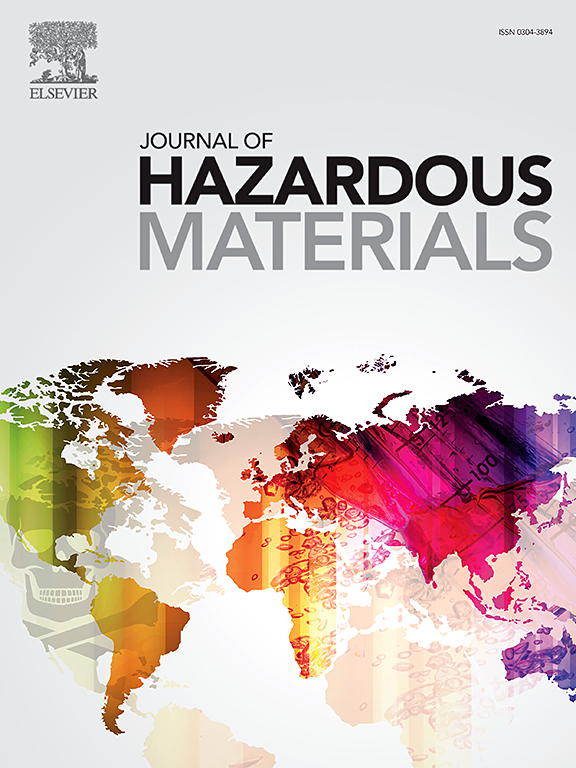水合铁纳米颗粒影响高岭石包覆砂柱中Cu(II)输运的定量预测和机理研究
IF 11.3
1区 环境科学与生态学
Q1 ENGINEERING, ENVIRONMENTAL
引用次数: 0
摘要
胶体颗粒在重金属在土壤中的迁移中起着重要的作用,但定量预测胶体对重金属迁移和生物有效性的影响仍然具有挑战性。本研究考察了水合铁纳米颗粒(Fh-NPs)对高岭石包覆砂柱中Cu(II)的运输和空间分布的影响。当Fh-NPs预吸附在高岭石上或与Cu(II)共迁移时,它们会阻碍Cu(II)在高岭石包覆砂柱中的迁移。有Fh-NPs时,Cu(II)的阻滞因子是无Fh-NPs时的1.19 ~ 1.52倍,表明Cu(II)的滞留量显著增加。计算出的铜(II)的滞留量(0.0042-0.0166 mg g⁻¹,pH值为3.0-5.5)与实验值(0.0044-0.0170 mg g⁻¹)非常吻合,强调了理论模型的可靠性。我们的研究还表明,Cu(II)在高岭石和Fh-NPs表面的吸附机制都涉及双齿双核球内配合物的形成。与Cu - al /Si相比,Cu - fe原子间距离较短,这是Cu(II)与Fh-NPs键合稳定性增强的原因。本研究定量检测了饱和多孔介质中胶体介导的Cu(II)转运,并通过分子相互作用阐明了其潜在机制。这些发现为加强污染物迁移模型、改进风险评估和制定有针对性的补救策略提供了重要见解。天然土壤中丰富的胶体颗粒对重金属迁移有显著影响。定量预测胶体对重金属迁移和生物可利用性的影响对环境污染管理具有重要意义。本研究定量评估了水合铁纳米颗粒(Fh-NPs)对高岭石-砂柱中Cu(II)迁移和形态分布的影响。提出了一种定量预测Fh-NPs对Cu(II)在高岭石多孔介质中输运影响的方法。基于分子尺度和胶体化学界面反应阐明它们的相互作用机理。研究结果为优化运输模式、改进风险评估和指导修复策略提供了支持。本文章由计算机程序翻译,如有差异,请以英文原文为准。

Quantitative prediction and mechanistic insights into Cu(II) transport in kaolinite-coated sand columns affected by ferrihydrite nanoparticles
Colloidal particles play a significant role in the transport of heavy metals in soil, but quantitative prediction of the impact of colloids on their migration and bioavailability remains challenging. This study examines the impact of ferrihydrite nanoparticles (Fh-NPs) in influencing the transport and spatial distribution of Cu(II) within a kaolinite-coated sand column. When Fh-NPs are pre-adsorbed on kaolinite or co-migrate with Cu(II), they hinder the migration of Cu(II) in kaolinite-coated sand columns. The observed retardation factor of Cu(II) with Fh-NPs was 1.19-1.52 times higher than in their absence, indicating a notable increase in Cu(II) retention. Calculations of Cu(II) retention (0.0042–0.0166 mg g⁻¹ at pH 3.0-5.5) closely matched experimental values (0.0044–0.0170 mg g⁻¹), underscoring the reliability of the theoretical model. Our study also showed that the adsorption mechanism of Cu(II) on both kaolinite and Fh-NPs surfaces involved the formation of bidentate binuclear inner-sphere complexes. The shorter Cu–Fe interatomic distance, compared to Cu–Al/Si, accounted for the enhanced bonding stability of Cu(II) with Fh-NPs. This study quantitatively examined colloidal-mediated Cu(II) transport in saturated porous media, elucidating its underlying mechanisms through molecular interactions. The findings provided critical insights for enhancing contaminants transport modeling, improving risk assessment, and developing targeted remediation strategies.
Environmental Implication
Abundant colloidal particles in natural soils significantly impact heavy metal migration. Quantitatively predicting colloid effects on heavy metal migration and bioavailability is crucial for environmental pollution management. This study quantitatively assessed the impact of ferrihydrite nanoparticles (Fh-NPs) on Cu(II) transport and morphological distribution in kaolinite-sand columns. A method was proposed to quantitative predicted the influence of Fh-NPs on the transport of Cu(II) in kaolinite porous media. Elucidating their interaction mechanisms based on molecular-scale as well as colloidal chemical interface reactions. Results supported optimizing transport models, improving risk assessment, and guiding remediation strategies.求助全文
通过发布文献求助,成功后即可免费获取论文全文。
去求助
来源期刊

Journal of Hazardous Materials
工程技术-工程:环境
CiteScore
25.40
自引率
5.90%
发文量
3059
审稿时长
58 days
期刊介绍:
The Journal of Hazardous Materials serves as a global platform for promoting cutting-edge research in the field of Environmental Science and Engineering. Our publication features a wide range of articles, including full-length research papers, review articles, and perspectives, with the aim of enhancing our understanding of the dangers and risks associated with various materials concerning public health and the environment. It is important to note that the term "environmental contaminants" refers specifically to substances that pose hazardous effects through contamination, while excluding those that do not have such impacts on the environment or human health. Moreover, we emphasize the distinction between wastes and hazardous materials in order to provide further clarity on the scope of the journal. We have a keen interest in exploring specific compounds and microbial agents that have adverse effects on the environment.
 求助内容:
求助内容: 应助结果提醒方式:
应助结果提醒方式:


